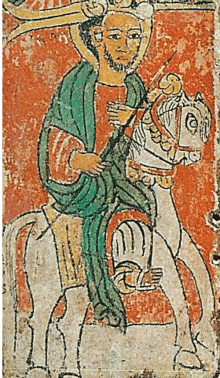Gebre Mesqel Lalibela
| Lalibela | |
|---|---|
 15th-century painting of Emperor Lalibela | |
| Reign | 1181 – 1221 |
| Predecessor | Kedus Harbe |
| Successor | Na'akueto La'ab |
| Born |
1162 Adefa or Roha, Bugna district |
| Died | 1221 (aged 58–59) |
| Spouse | Masqal Kibra |
| Issue | Yetbarak |
| Dynasty | Zagwe dynasty |
| Father | Jan Seyum |
Lalibela (Ge'ez: ላሊበላ), regnal name Gebre Meskel (Ge'ez: ገብረ መስቀል, lit. 'Servant of the Cross'; 1162 – 1221) was Emperor of Ethiopia of the Zagwe dynasty, reigning from 1181 to 1221.[1][2] According to Taddesse Tamrat, he was the son of Jan Seyum and brother of Kedus Harbe. Perhaps the most well-known of the Zagwe monarchs, the namesake monolithic churches of Lalibela are attributed to his reign, although recent scholarship has suggested origins as early as the late Aksumite period, with the complex reaching its present form during his time. He is venerated as a saint by the Orthodox Tewahedo churches.
Biography
King Lalibela was born at either Adefa or Roha (it was later named Lalibela after him) in Bugna in 1162 AD. He was given the name "Lalibela", meaning "the bees recognise his sovereignty" in Old Agaw, due to a swarm of bees said to have surrounded him at his birth, which his mother took as a sign of his future reign as Emperor of Ethiopia. Tradition states that he went into exile due to the hostility of his uncle Tatadim and his brother king Kedus Harbe, and was almost poisoned to death by his half-sister. Because Lalibela came to power during his brother's lifetime, Taddesse Tamrat suspects that he came to power by force of arms.[3]
Lalibela is said to have seen Jerusalem in a vision and then attempted to build a new Jerusalem as his capital in response to the capture of old Jerusalem by Muslims in 1187. As such, many features of the town of Lalibela have Biblical names including the town's river, known as the River Jordan (Amharic: ዮርዳኖስ ወንዝ, translit. Yordanos Wenz). The city remained the capital of Ethiopia from the late 12th century and into the 13th century.
Details about the construction of his 11 monolithic churches at Lalibela have been lost. The later Gadla Lalibela, a hagiography of the king, states that he carved these churches out of stone with only the help of angels.[4] According to the narrative of the Portuguese embassy to Ethiopia in 1520-6, written down by Father Francisco Alvarez and published 1540, the Lalibelian priests claimed that the churches took 24 years to construct, and that they were made by white men. They said that King Lalibela ordered this to be done. [5]
His chief queen was Masqal Kibra, about whom a few traditions have survived. She induced Abuna Mikael to make her brother Hirun bishop, and a few years later the Abuna left Ethiopia for Egypt, complaining that Hirun had usurped his authority.[6] Another tradition states that she convinced king Lalibela abdicate in favor of his nephew Na'akueto La'ab, but after 18 months of his nephew's misrule she convinced Lalibela to resume the throne. Taddesse Tamrat suspects that the end of Lalibela's rule was not actually this amiable, and argues that this tradition masks a brief usurpation of Na'akueto La'ab, whose reign was ended by Lalibela's son, Yetbarak.[7] Getachew Mekonnen credits her with having one of the rock-hewn churches, Bet Abba Libanos, built as a memorial for Lalibela after his death.[8]
Although little written material concerning the other Zagwe kings survives, a sizeable quantity concerning Lalibela's reign remains, besides the Gadla Lalibela. An embassy from the Patriarch of Alexandria visited Lalibela's court around 1210, and have left an account of him, and Na'akueto La'ab and Yetbarak.[9] The Italian scholar Carlo Conti Rossini has also edited and published the several land grants that survive from his reign.[10]
References
- ↑ Getachew Mekonnen Hasen, Wollo, Yager Dibab (Addis Ababa: Nigd Matemiya Bet, 1992), p. 22.
- ↑ Taddesse Tamrat, Church and State in Ethiopia (Oxford: Clarendon Press, 1972), p. 56n.
- ↑ Taddesse Tamrat, p. 61.
- ↑ The portion of his Gadla describing his construction of these churches has been translated by Richard K. P. Pankhurst in his The Ethiopian Royal Chronicles (Addis Ababa: Oxford University Press), 1967.
- ↑ C.F. Beckingham and G.W.B Huntingford (eds), The Prester John of the Indies: A True Relation of the Lands of Prester John, being the Narrative of the Portugese Embassy to Ethiopia in 1520 written by Father Francisco Alvarez, Cambridge, published for the Hakluyt Society at the University Press, 1961, vol I. p. 227.
- ↑ Taddesse Tamrat, pp. 59f.
- ↑ Taddesse Tamrat, pp. 62f.
- ↑ Getachew Mekonnen, p. 24.
- ↑ Taddesse Tamrat, p. 62.
- ↑ A bibliography for these can be found at Taddesse Tamrat, p. 59.
External links
- J. Perruchon. Vie de Lalibala, roi d'éthiopie: texte éthiopien et traduction française. Paris 1892. (Online version in Gallica website at the Bibliothèque nationale de France)
| Regnal titles | ||
|---|---|---|
| Preceded by Kedus Harbe |
Emperor of Ethiopia | Succeeded by Na'akueto La'ab |